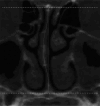Nasal septum deviation after rapid maxillary expansion in the early mixed dentition
- PMID: 39820466
- PMCID: PMC11842104
- DOI: 10.2319/050124-344.1
Nasal septum deviation after rapid maxillary expansion in the early mixed dentition
Abstract
Objectives: To evaluate nasal septum changes after rapid maxillary expansion (RME) during the mixed dentition and to verify the association between quantitative and qualitative assessments of nasal septum deviation (NSD) by ear, nose, and throat (ENT) specialists.
Materials and methods: The sample comprised 24 patients (11 male, 13 female) with a mean age of 7.62 ± 0.92 years with maxillary transverse deficiencies. Cone-beam computed tomography (CBCT) images were obtained before and after RME. Three CBCT coronal sections passing through the maxillary first molars, 5 mm anterior and 5 mm posterior, were used for quantitative assessment. NSD was calculated using the ratio of nasal cavity height to nasal septum contour. Additionally, five ENT professionals evaluated NSD qualitatively using scores from 1 to 3 through CBCT sequential axial and coronal sections. Absent NSD was scored as zero. Interstage changes were assessed using Wilcoxon tests. Spearman correlation and linear regression were performed to evaluate the association between quantitative and qualitative analyses (P < .05).
Results: No significant change was observed in the NSD ratio. In pre-expansion CBCT images, absence of NSD and scores 1, 2, and 3 for NSD were found for 45.8%, 41.7%, 12.5%, and 0%, respectively. In the qualitative assessment, no significant change in NSD was observed after expansion. A strong association was found between NSD ratio and ENT score (r = 0.750).
Conclusions: In the mixed dentition, no significant change was observed in the NSD ratio. Qualitative analysis of NSD was associated with quantitative assessment of the ratio between nasal septum contour and nasal cavity height.
Keywords: Mixed dentition; Nasal cavity; Nasal septum; Palatal expansion technique; Respiratory airflow.
© 2025 by The EH Angle Education and Research Foundation, Inc.
Figures




References
-
- Cappellette M, Jr.,, Nagai LHY, Gonçalves RM, Yuki AK, Pignatari SSN, Fujita RR. Skeletal effects of RME in the transverse and vertical dimensions of the nasal cavity in mouth-breathing growing children. Dental Press J Orthod. 2017;22(4):61–69. 10.1590/2177-6709.22.4.061-069.oar - DOI - PMC - PubMed
MeSH terms
LinkOut - more resources
Full Text Sources
Research Materials
Miscellaneous

